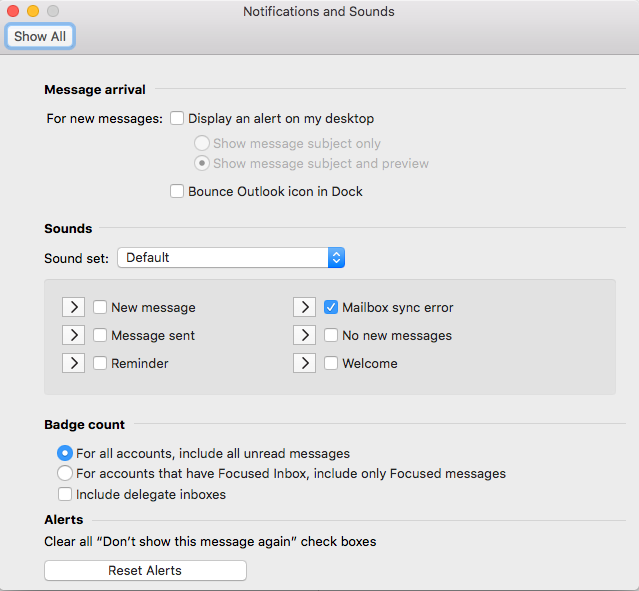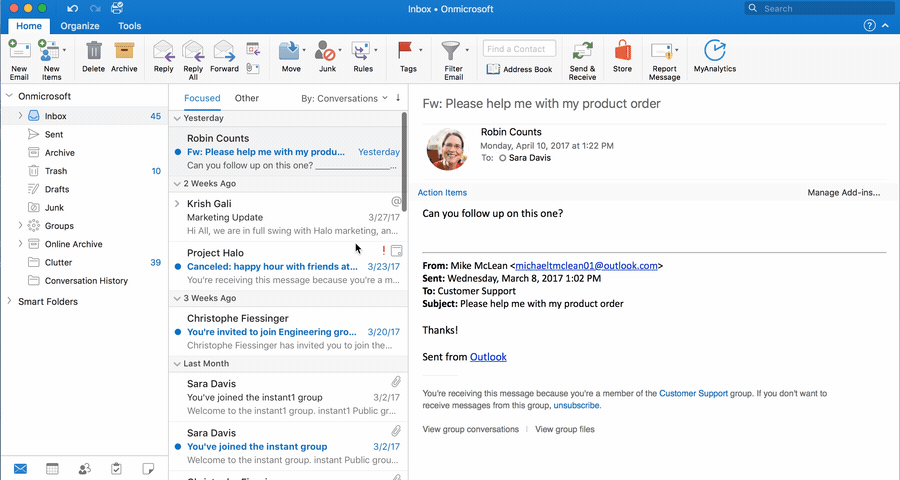This tool also stores the settings for the Outlook window size and position. This tool shouldn't be needed most of the time. But it can be useful. Note The Outlook Preferences file doesn't contain all the preferences for the application. Also, resetting Outlook preferences doesn't remove email messages or account settings. How to use the tool. Coming to Outlook for iOS May 2018. Available in Outlook for Windows, Mac, and Android. Office Lens technology in Outlook for Android—When you need to capture and share details in the form of an image, such as a whiteboard, photo, or document, we’ve added a new photo icon to Outlook integrated with Office Lens technology. Simply start a new.
When I receive an email from a certain contact or Contact Group, can I get a different “New Email” sound than the default?
You can set a custom sound for a specific contact (or by a variety of any other specific message property) by using a rule.
- Open the Rules and Alerts wizard:
- Outlook 2007 and previous
Tools-> Rules and Alerts… - Outlook 2010, Outlook 2013 and Outlook 2016
File-> Manage Rules & Alerts
- Outlook 2007 and previous
- Press the New Rule… button and start with a blank rule:
- Outlook 2003
Start from a blank rule - Outlook 2007
Check messages when they arrive - Outlook 2010, Outlook 2013 and Outlook 2016
Apply rule on messages I receive
- Outlook 2003
- In the next screen you can select the conditions.
In our case we select: from people or public group. - In the bottom section, click “people or public group” to select the address(es) from your Address Book.
- Click Next to go to the Actions screen.
- Select the action: play a sound.
- In the bottom section click “a sound” to select a sound file from your computer.
- Note that you should use a wav-file for this.
- Click next to advance to the next screen to set any exceptions when needed.
- Once you’ve done that (or skipped that), click Next to give the rule a name.
- Click Finish and then OK to close the open windows.
Via the “Play a Sound” rule action, you can hear who is emailing you.
Note: You can of course make many variations with this rule. For instance, you can opt to only hear a sound for people who are in your Contacts folder and disable the default sound in Outlook altogether (see below). For this you must use the condition “sender is in specified Address Book”.
Double New Mail Sound
When a new message arrives, you could now hear a double sound; the default Outlook sound and the one we just configured to play via a rule.
You can work around this by disabling the default sound in Outlook and instead create an extra “play a sound” rule with the default Windows Notify Email.wav sound.
Additionally, add the condition “stop processing rules” action to the rule we created for the specific contact and sort the rules in such a way that the rule for the specific contact is listed above the one for playing the generic sound.
To disable the default email sound in Outlook go to;
- Outlook 2007 and previous
Tools-> Options…-> E-mail Options…-> Advanced E-mail Options…-> section: When new items arrive in my Inbox-> option: Play a sound - Outlook 2010, Outlook 2013 and Outlook 2016
File-> Options-> section: Mail-> option group: Message arrival-> option: Play a sound
Outlook For Mac Create Sound Set 2018 New
Summary
This article describes some useful tools for Microsoft Outlook for Mac.
More information
Outlook Search Repair
The Outlook Search Repair tool repairs search results within Outlook.
Important
Due to some changes in macOS Mojave, this tool no longer works in 10.14 and higher. If you are on macOS Mojave (10.14), you can follow the steps below to reindex Spotlight for Outlook for Mac.
Choose Apple menu, then System Preferences, and then Spotlight.
Select the Privacy tab.
In Finder:
On the Go menu, select Go to Folder...
Copy and paste the following location into the 'Go to the folder:' dialog box and select Go:
~/Library/Group Containers/UBF8T346G9.Office/Outlook/Outlook 15 Profiles/
Drag the 'Main Profile' folder to the Privacy tab. Once added, remove the folder from the Privacy tab, and Spotlight will re-index the folder.
You must perform this step for any additional profile folders you have.
See the following article from Apple to learn more: How to rebuild the Spotlight index on your Mac.

When to use the tool
Use this tool if search results within Outlook show nothing or return older items only. For example, if you search for an email message that you already have open and that message isn't displayed in the search results.
How to use the tool
Download and open the Outlook Search Repair tool.
Follow the instructions.
Note The tool searches for duplicate installations of Outlook. If no duplicates are detected, go to step 3. If duplicates are detected, remove the duplicate Outlook installations, and then restart the system. After your system is restarted, the Outlook Search Repair tool may reopen. If it does reopen, exit and restart the tool.
Select Reindex.
Note The Outlook Search Repair tool displays a 'Reindexing, please wait' message while it works. Wait for this process to finish. This may require an hour or more, depending on the size of your Outlook profile. Outlook doesn't have to be open when the repair occurs. A spotlight search will be slower and may not finish while the index is being repaired.
Exit the Outlook Search Repair tool when you receive the following message after the repair is completed:
Done! Reindexing has completed!
OutlookResetPreferences
The Outlook Reset Preferences tool resets all Outlook preferences to their default settings.
When to use the tool

Use this tool to reset any customizations that you've made to Outlook by using the Preferences option on the Outlook menu. This tool also stores the settings for the Outlook window size and position. This tool shouldn't be needed most of the time. But it can be useful.
Note The Outlook Preferences file doesn't contain all the preferences for the application. Also, resetting Outlook preferences doesn't remove email messages or account settings.
How to use the tool
- Download and open the Outlook Reset Preferences tool.
- Click the Reset Now! button. This closes Outlook if it's open, and then resets the preferences to their default settings.
- Exit the Outlook Reset Preferences tool.
SetDefaultMailApp
The Default Mail Application tool lets you easily make Outlook the default mail application.
When to use the tool
Use this tool if you want Outlook to open a new email message when you click a mailto: link in an email message or on a website. Selecting a mailto: link opens the default email application. Outlook isn't the default email application until you change that setting.
How to use the tool
- Download and open the Default Mail Application tool.
- In the Default Mail Application dialog box, select com.microsoft.outlook, and then click Make Default.
- Exit the Default Mail Application tool.
ResetRecentAddresses
The Reset Recent Addresses tool lets you reset recent addresses that Outlook stores. This tool deletes all recent addresses instead of you having to manually delete addresses one at a time.
Outlook For Mac Create Sound Set 2018 Review
When to use the tool

When you compose an email message and add people on the To, Cc, or Bcc line, Outlook suggests names as you type characters. The list of names that Outlook uses is a combination of stored contacts, the company directory, and recent contacts. Recent contacts have an 'X' character next to each name. Without this tool, you have to click the 'X' on each contact to remove that contact from the Recent Address List. The Reset Recent Addresses tool cleans out all recent addresses at the same time.
How to use the tool
- Download and open the ResetRecentAddresses tool.
- Click the Reset Now! button.
- Exit the Reset Outlook Recent Addresses tool.